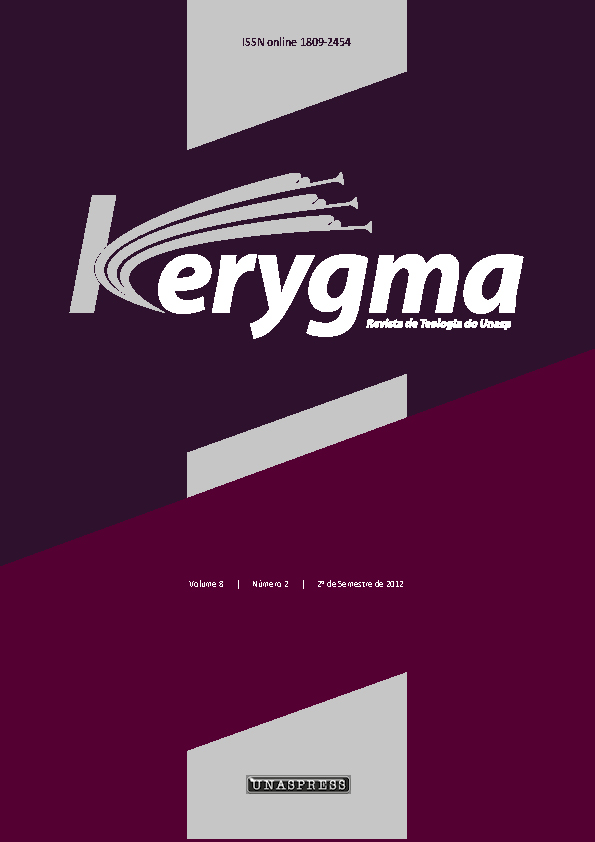Abstract
he first comming of the Messiah happened when the characteristics
were appropriate for this event. One of them was the opposition of the
groups of Judaism, the Pharisees and Sadducees, and of the Helenism, Stoics and Epicureus. The factions of Judaism were totally opposite in their ideologies. The followers of the phylosophical tendencies of helenism were different in their fundamental convictions. Therefore, standing up to the rising christianity, these sides got together thanks to an essential belief of their convictions. The second comming of the Messiah will happen in the “fulness of the times”, and one of the characteristics of this time will be the gathering of opposite groups which will put away their differences to face the genuine christianity. This study intends to identify ideologically who are the Pharisees and the Saducees, in one side, and the Stoics and Epicureus in the other on the end of the times.
References
ÁVILA, F. J. Pequena enciclopédia de doutrina social da igreja. São Paulo: Edições Loyola, 1991.
BEACH, B. B. Vatican II: Bridging the Abyss. Washington: Review and Herald Publishing Association, 1968.
BOCHENSKI, I. M. A Filosofia contemporânea ocidental. São Paulo: Editora da Universidade de São Paulo, 1975.
BROWN, C. Filosofia e fé cristã. São Paulo: Edições Vida Nova, 1999.
BRYANT, T. A. (Ed.). Today’s dictionary of the Bible. Laredo: Bethany House Publishers, 1982.
BULTMANN, R. Primitive christianity. New York: The Fontana Library, 1962.
COLEMAN, W. The pharisees guide to the total holiness. Laredo: Bethany House Publishers, Minn. Min. 1977.
DAVIDSON, B. Analytical hebrew and chaldee lexicon. Michigan: Zondervan Publishing House, 1979.
FERGUSON, E. Background of the early christianit. Grand Rapids: William B. Eerdmans Publishing Company, 1987.FREND, W. C. Martyrdom and persecution in the early church. New York: Anchors
Books, Doubleday & Co. Inc, 1967.
GEISLER, N. L. The new age movement. Biblioteca Sacra, jan. - mar., p. 82, 1987.
GOODFIELD, J. Playing God. London: Hutchinson & Company, 1975.
LIRA, E. C. As armadilhas da nova era. Ministério, mar. — abr. p. 5, 1993.
MOORE, H. C. Desde pentecostés hasta patmos. El Paso: Casa Bautista de Publicaciones, 1978.
MOORE. H. C. Desde pentecostés hasta patmos. El Paso: Casa Bautista, 1951.
NEANDER, A. General history of the christian religion and church. London: Edinburg T. & T. Clark, 1847, v. 1.
NEWMANN, A. H. A manual of church history. Boston: Mass, 1933. v. 1.
PERES, A. Entrevista. Revista Claudia, mar. p. 40-42, 1990.
SCHAFF, P. History of the christian church. Grand Rapids: W. B. Eerdmans Pub. Co. 1967. v. 1.
THE ANALYTICAL greek lexicon: grammatical analisys of each word. New York: Harper and Brothers, [19--?].
TILLICH, P. A history of christian thought. Michigan: Harper and Row Publisher, 1968.
TREDICI, J. Breve corso di Storia della filosofia. Roma: Edizioni Cardinal Ferrari, 1963.
TYSON, J. The new testament and early christianity. New York: Macmillan Pub. Co. 1984.
Authors who publish on Kerygma must agree to the following terms:
- Once accepted for publication, the copyright of articles is automatically transferred to Kerygma.
- All material used in the text that is copyrighted by third parties must be duly referenced.
- Authors must also retain the reproduction rights of images and tables in their material, if necessary.
- The authors guarantee that the submitted text is entirely their authorship and has not been submitted and/or published elsewhere.
- The opinions, ideas and concepts expressed in the texts are the sole responsibility of their authors and do not necessarily represent the opinion of Kerygma;
- The editors reserve the right to make textual adjustments and adapt to the publication's norms.
- Authors retain copyright and grant the journal the right of first publication, with the work simultaneously licensed under Creative Commons Attribution-NonCommercial 4.0 International, which allows sharing of the work with acknowledgment of authorship and initial publication in this journal. This license allows others to remix, adapt, and build upon your work non-commercially, as long as they give proper credit to you and their new works are not used for commercial purposes. However, users are not required to license those derivative works under the same terms.
- The authors agree with the free reproduction of their material by Kerygma, which may adapt, modify, condense, summarize, reduce, compile, expand, alter, mix with other content, include images, graphics, digital objects, infographics and hyperlinks, illustrate, diagram, divide, update, translate and carry out any other transformations, requiring the participation or express authorization of the authors.
- The authors agree that Kerygma can distribute the articles through cable, fiber optics, satellite, airwaves or any other system that allows access to the user at a specific time and place, either by free channels or by systems that import payment. Kerygma may also include work in a physical or virtual database, archiving in printed format, storing on a computer, in a cloud system, microfilming and other current forms of archiving or that may still be developed, with or without profit.
- Authors are permitted to enter into separate, additional agreements for the non-exclusive distribution of the published version of the work in this journal (e.g., publishing it in an institutional repository or as a book chapter), with acknowledgment in the new publication of its initial publication in this journal.
- Kerygma owns the rights to all works published by it. The full reproduction of these texts in other publications, for any other purpose, by any means, requires written authorization from the publisher. The same goes for partial reproductions, such as summary, abstract, portions with more than 500 words of the text, tables, figures, illustrations, etc.
- Authors are granted permission and encouraged to publish and distribute their work online (e.g., in institutional repositories or on their personal websites) at any point before or during the editorial process. This is because it can lead to productive alterations and increase the impact and citation of the published work. (See "The effect of open access and downloads ('hits') on citation impact: a bibliography of studies.")

